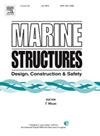海上风力机单桩全非线性波浪荷载的数据驱动模型
IF 4
2区 工程技术
Q1 ENGINEERING, CIVIL
引用次数: 0
摘要
海上风能是可再生能源组合的重要组成部分,准确有效地预测单桩基础上的非线性波浪荷载对于确保结构完整性和延长风力涡轮机的使用寿命至关重要。与大体积海洋结构不同,由于环形响应,对于这种细长结构来说,三阶和更高的波浪荷载非常重要。传统的方法,如基于完全非线性势流理论和计算流体动力学(CFD)的数值波槽,通常计算成本很高。本文提出了使用机器学习(ML)技术的数据驱动方法来模拟非线性波浪荷载。这些方法大大降低了计算成本,同时在一系列波浪条件下保持高阶波浪载荷的合理预测精度。基于高保真CFD数据开发和训练了两个基于ml的模型,以捕获线性和非线性波浪载荷分量,其中CFD数据使用K-means算法进行分类,这是一种优化数据集的无监督聚类技术。从每个聚类中选择一个具有代表性的数据子集来构建ML模型的训练和测试数据集,确保捕获足够的模式以促进模型训练和泛化。第一个ML模型实现了一种混合方法来预测时域的非线性波载荷。它结合了基于物理的线性预测器和长短期记忆(LSTM)预测器来估计线性模型和CFD结果之间的残差。第二种模型采用降阶建模的精神,在频域预测非线性波动荷载的基次谐波和高次谐波,然后将其重构到时域。两种模型的比较研究表明,第二种基于ml的方法对于目前的应用更具鲁棒性,消除了过拟合和欠拟合高频振荡之间的权衡,这是第一个模型中固有的问题。我们还比较了ML模型与FNV波荷载模型的性能(Faltinsen et al., 1995;Kristiansen and Faltinsen, 2017)。将所提出的ML模型应用于各种波浪条件下的非线性波浪荷载预测,研究了最大力和力非线性的变化规律。本文章由计算机程序翻译,如有差异,请以英文原文为准。
Data-driven modelling of fully nonlinear wave loads on offshore wind-turbine monopiles at prototype scale
Offshore wind energy constitutes a vital component of the renewable energy portfolio, and accurate and efficient prediction of nonlinear wave loads on monopile foundations is critical for ensuring structural integrity and prolonging wind turbines’ operational lifespans. Unlike large-volume marine structures, third-order and higher wave loading is important for such slender structures due to ringing response. Traditional approaches, such as the numerical wave tank based on the fully nonlinear potential flow theory and computational fluid dynamics (CFD), are often computationally expensive. This paper proposes data-driven approaches to model nonlinear wave loads using machine learning (ML) techniques. These approaches offer substantial reductions in computational cost while maintaining reasonable predictive accuracy for high-order wave loadings under a range of wave conditions. Two ML-based models are developed and trained based on high-fidelity CFD data to capture linear and nonlinear wave load components, where the CFD data are classified into clusters using the K-means algorithm, an unsupervised clustering technique to optimise the dataset. A representative subset of data is selected from each cluster to construct the training and testing datasets for the ML models, ensuring that sufficient patterns are captured to facilitate model training and generalisation. The first ML model implements a hybrid approach to predicting the nonlinear wave load in the time domain. It combines a physics-based linear predictor for the inline force with a long short-term memory (LSTM) predictor to estimate the residual between the linear model and CFD results. The second model adopts the spirit of reduced-order modelling by predicting the fundamental and higher-order harmonics of the nonlinear wave load in the frequency domain, which are subsequently reconstructed into the time domain. A comparative study of the two models reveals that the second ML-based approach is more robust for the present application, eliminating the trade-off between overfitting and underfitting high-frequency oscillations, an inherent issue in the first model. We also compare the performance of the ML model with the FNV wave load model (Faltinsen et al., 1995; Kristiansen and Faltinsen, 2017). The proposed ML model is applied to predict nonlinear wave loads under various wave conditions, and the variation of maximum force and force nonlinearity is investigated.
求助全文
通过发布文献求助,成功后即可免费获取论文全文。
去求助
来源期刊

Marine Structures
工程技术-工程:海洋
CiteScore
8.70
自引率
7.70%
发文量
157
审稿时长
6.4 months
期刊介绍:
This journal aims to provide a medium for presentation and discussion of the latest developments in research, design, fabrication and in-service experience relating to marine structures, i.e., all structures of steel, concrete, light alloy or composite construction having an interface with the sea, including ships, fixed and mobile offshore platforms, submarine and submersibles, pipelines, subsea systems for shallow and deep ocean operations and coastal structures such as piers.
 求助内容:
求助内容: 应助结果提醒方式:
应助结果提醒方式:


